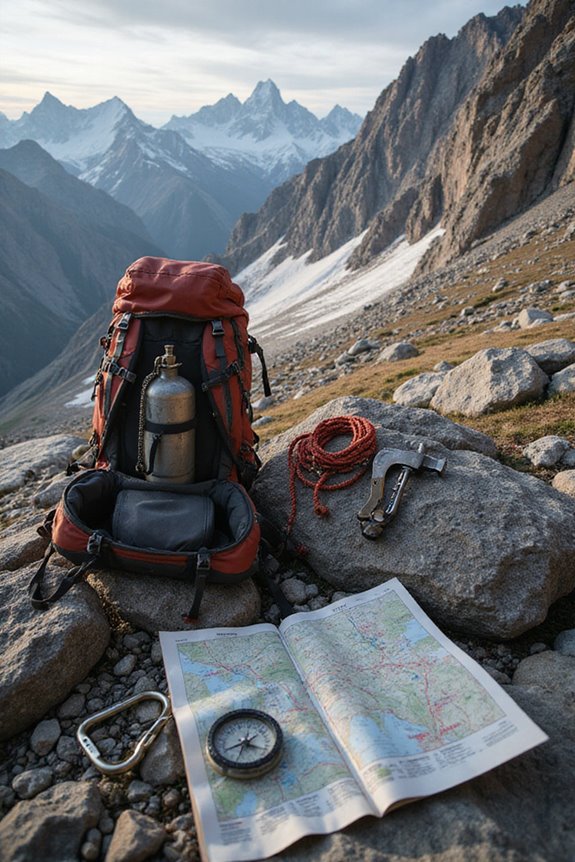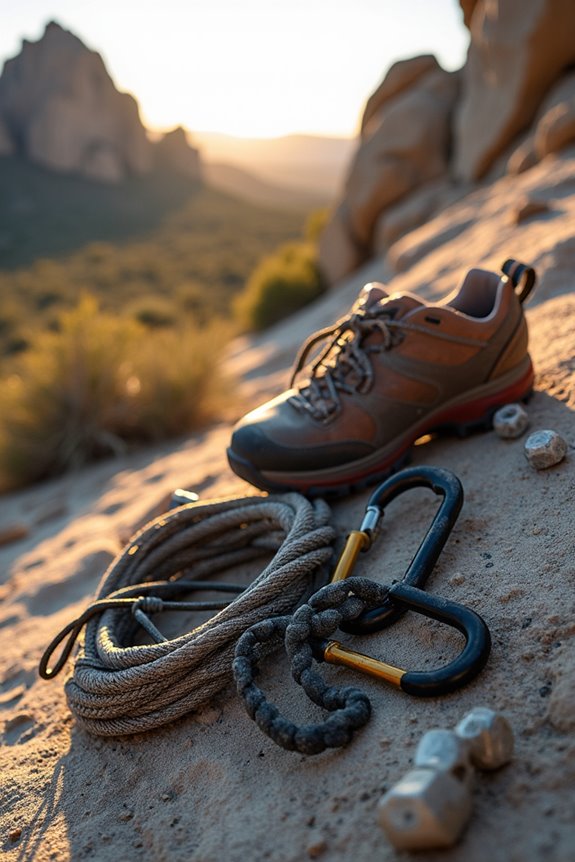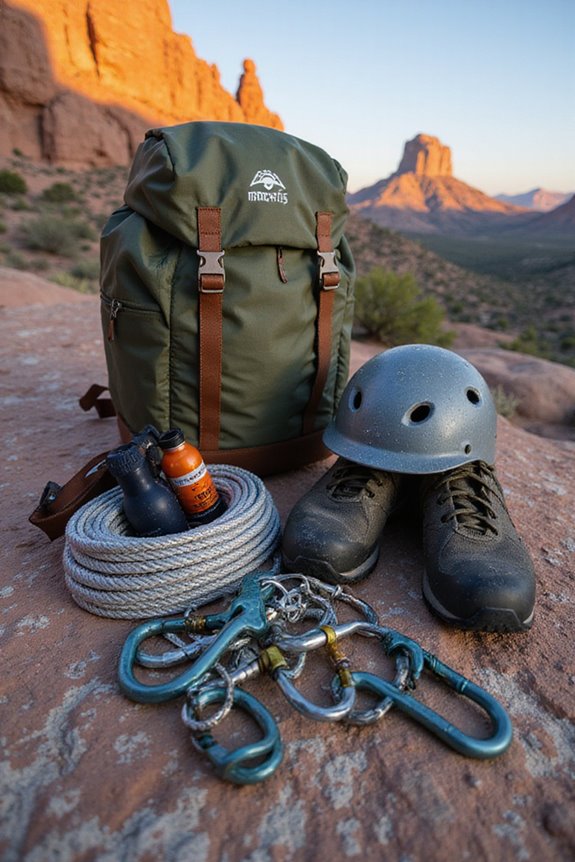When it comes to high altitude climbing, we’ve got to mix savvy acclimatization techniques and solid physical conditioning! Let’s embrace the “climb high, sleep low” strategy and sip water like it’s our best friend—aim for 3-5 liters a day. Keeping our snacks high-calorie will zap fatigue, while sturdy gear, like the La Sportiva Makalu boots, will have us conquering icy paths. Trust me, mastering these tips means we can tackle any summit! Stick around, and we’ll cover more essentials!
Key Takeaways
- Employ the “climb high, sleep low” technique to enhance acclimatization and reduce altitude sickness risk.
- Maintain hydration by drinking 3-5 liters of water daily, using mini sips every 20-30 minutes.
- Limit elevation gains to 300-500 meters per day and schedule regular rest days to monitor fatigue and symptoms.
- Use durable climbing gear, ensuring safety equipment is in good condition and clothing is moisture-wicking and layered for warmth.
- Carry emergency survival gear and a waterproof jacket to prepare for sudden weather changes during your climb.
Acclimatization Techniques
When we’re gearing up for high altitude climbing, acclimatization techniques become our best friends! It’s all about those acclimatization stages—slow and steady wins the race. We love the strategy of “climb high, sleep low,” where we explore higher elevations during the day but retreat to lower altitudes to rest. This approach keeps altitude adaptation on track.
Scheduling rest days is a must; they’re our time to recharge and check for any altitude sickness symptoms. Plus, we should limit our elevation gains to about 300-500 meters per day—no need to conquer Everest in one leap! Staying hydrated and fueled helps us combat those pesky altitude effects. Always pack emergency survival gear to ensure safety during unexpected weather changes or emergencies at high elevations. Let’s embrace the gradual journey and enjoy the breathtaking views along the way!
Physical and Mental Conditioning
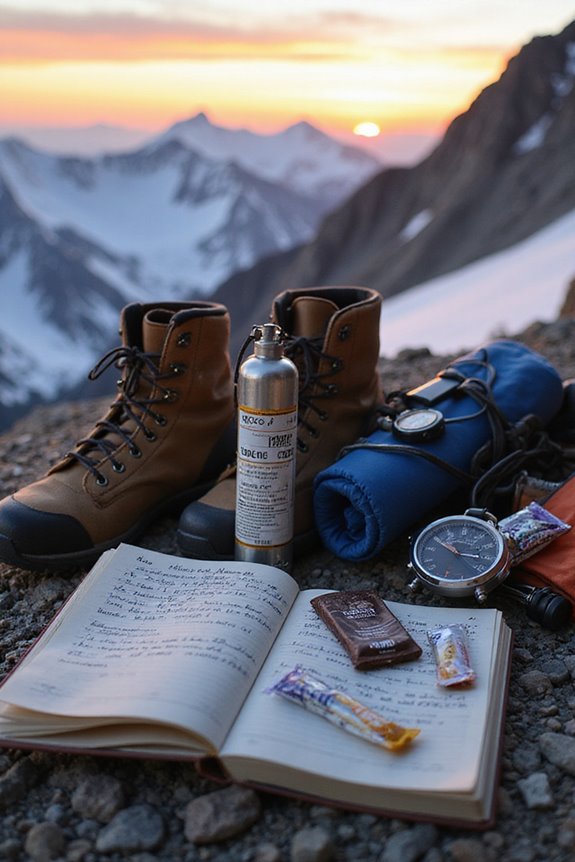
Physical and mental conditioning is our secret weapon for conquering high-altitude challenges! We can’t just show up at the summit; we’ve gotta put in the work. Let’s crank out 4-6 endurance workouts each week, embracing all sorts of aerobic fun like trail running and stair-stepping. Trust me, those uphill grinds will pay off!
Don’t forget our strength training—focusing on those quads and glutes will help us tackle any ascent with ease. Pair it with yoga for flexibility and core stability, ensuring we can stay balanced on those rocky paths.
And let’s hone our mental game! Visualization and mindfulness can transform our outlook. Picture your victory; it’s half the battle! Ready to embrace the adventure? Let’s do this!
Using quality compression sacks can reduce your gear bulk by up to 60%, making your high-altitude expedition much more efficient and comfortable.
Understanding Terrain Hazards
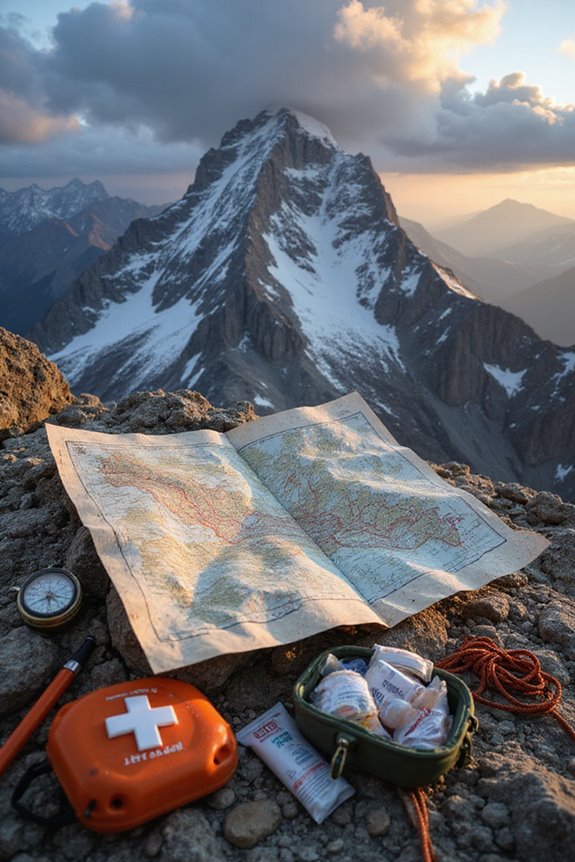
Let’s get real about high-altitude climbing—we’re not just battling elevation; we’re facing a whole host of terrain hazards that can turn an adventurous trek into a nail-biting scramble. First off, we need to talk avalanche safety. These beasts can bury us in seconds; staying alert to snow conditions and terrain features is critical. Trust me, we don’t want to become a statistic!
And then there are those sneaky crevasses, lurking like mischievous kids under snow bridges. Our survival rate drops rapidly if we’re not roped together. Let’s stick together, probe the snow, and keep an eye out. Remember, the mountains are majestic but they can also be downright unfriendly if we’re not cautious. So let’s embrace the thrill with a healthy dose of readiness! Always bring a waterproof jacket rated above 10,000mm to protect against sudden downpours and snowmelt that can lead to dangerous hypothermia at high altitudes.
Essential Climbing Gear
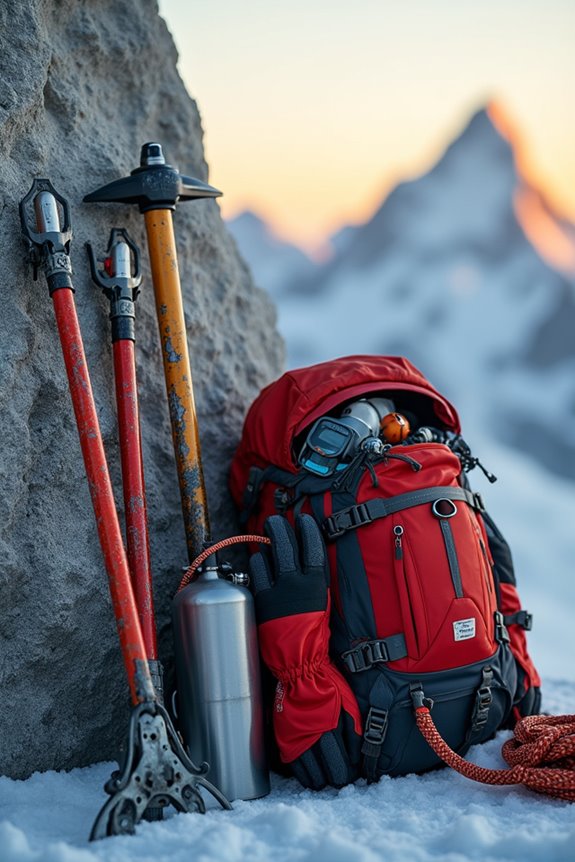
As we gear up for high-altitude adventures, having the right climbing gear isn’t just a luxury—it’s a necessity! First off, let’s talk climbing packs. We need something durable and spacious, with adjustable straps to balance the load. We can’t forget our dry ropes and extra batteries for essential electronics—they won’t do us much good if they freeze up!
Safety equipment is paramount, so helmets are non-negotiable, along with adjustable harnesses for that snug fit. Crampons? Absolutely! They’ll keep us from becoming accidental ice sculptures. For serious mountaineering, consider boots like the La Sportiva Makalu with full steel shanks that accommodate automatic crampons for snow climbing. Layering is key too—we should dress in moisture-wicking base layers and a robust outer shell. Let’s guarantee we’re equipped for anything Mother Nature throws our way—because freedom in the mountains starts with the right gear!
Hydration and Nutrition Strategies
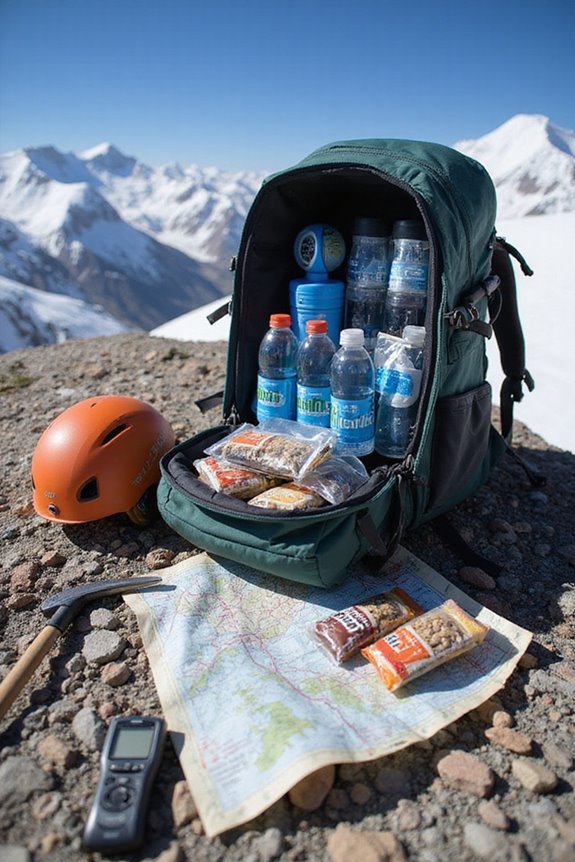
Now that we’ve got our gear sorted, let’s give our bodies the fuel they need to tackle those high-altitude challenges! Hydration is huge, so we should aim for at least 3-5 liters a day. Trust us, dehydration can seriously cramp our style on the trail. We need to establish hydration methods early—think mini sips every 20-30 minutes, not just when we’re thirsty.
Nutrition timing is key, too. We’re talking about high-calorie, nutrient-dense snacks like trail mix or energy bars every couple of hours. Let’s plan our meals well, and don’t forget those electrolytes! Add some tablets or powders; they’ll keep our energy up and muscle function sharp. Using a portable water filter ensures you can safely replenish your water supply from streams and lakes throughout your climb. Come on, let’s keep our momentum soaring!
Monitoring Health and Symptoms
When we’re starting high-altitude climbs, keeping a close eye on our health is as essential as packing that extra layer! It’s critical to engage in symptom tracking; recognizing headaches, nausea, and even that pesky loss of appetite can save us from a rough experience. Regular health assessments help us gauge how well we’re acclimatizing.
Are we feeling dizzy or lightheaded? That’s our cue to slow down. If anyone’s lips start to look Olympic blue, we need to act fast! Trust me, noting these signs in a journal not only aids us but keeps the spirit alive in our team. So, let’s embrace the freedom of the trail, but remember: our health’s got to share the spotlight!
Emergency Preparedness Plans
While we might dream of conquering lofty peaks, a solid emergency preparedness plan is our best friend on the trail! Before we lace up our boots, let’s nail down those emergency drills. Every team member should know the procedures; it can be the difference between a simple hiccup and a full-blown crisis.
A thorough risk assessment is key to understanding the potential hazards we face on the ascent. What routes, weather changes, or altitude effects might threaten our adventure?
And remember, even with the best laid plans, flexibility is our ally. The mountain often has surprises up its sleeve. Let’s arm ourselves with knowledge and gear, ensuring we’re ready for anything. Together, we’ll tackle those summits and create lasting memories!
Communicating During the Climb
Climbing up those breathtaking heights is thrilling, but let’s not forget that how we communicate can keep our adventure safe and fun. We always rely on radio communication for quick updates—especially when the winds howl and our voices get lost! But hey, rope tugs are our trusty sidekick too. A few tugs on the rope can say “I’m climbing” or “I need slack” without needing to shout.
Don’t underestimate standardized vocal commands—short and sweet syllables can cut through the chaos. Plus, mental preparation is key; staying calm and connected with each other helps us tackle environmental challenges. So, equip yourselves with the right communication tools, and let’s scale those heights together!
Frequently Asked Questions
What Are the Signs of Altitude Sickness I Should Watch For?
As we wander through the stunning heights, let’s stay vigilant for symptoms like headaches, fatigue, and dizziness. Awareness and effective prevention strategies can protect our adventure, ensuring we enjoy every breathtaking moment together!
How Can I Manage Cold Weather While Climbing?
When managing cold weather gear, we’ve found that layering techniques work wonders. We often wear a moisture-wicking base, insulating mid-layer, and a waterproof outer shell, allowing us to explore freely without losing warmth or comfort.
What Skills Are Essential for Basic Climbing Techniques?
We can’t just flail our arms and expect to conquer peaks! Mastering climbing fundamentals and technical skills—like precise footwork and proper body position—allows us to dance gracefully on the rock, embracing the freedom we crave.
How Should I Handle Emergencies in Remote Areas?
When handling emergencies in remote areas, we should always carry emergency gear and know rescue signals. That way, we can guarantee our safety and communicate effectively while waiting for help when we need it most.
What Should I Pack for a Multiday High-Altitude Trip?
As we stand at the precipice, the thrill of adventure beckons. Our packing checklist for those multiday high-altitude journeys must include gear essentials like a durable pack, navigation tools, and weatherproof clothing to embrace the wild.

